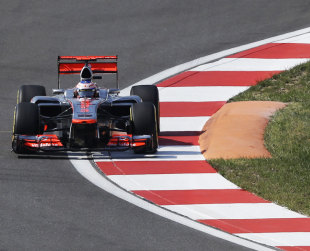- FIA news
FIA to restrict use of DRS in practice and qualifying in 2013

The FIA will restrict the use of DRS in free practice and qualifying next year so that it will only be used in the DRS zones rather than over the entire lap.
Since DRS was introduced in 2011, drivers have been able to activate the car's adjustable rear wing at any point of the lap during practice and qualifying. In races it is restricted to pre-defined overtaking zones to serve its purpose of allowing cars to overtake and these are the areas it will be restricted to in practice and qualifying from 2013.
The FIA originally left usage unrestricted so that teams could gain experience with the system to ensure it achieved its primary goal of boosting overtaking, but now the governing body believes the unlimited use of the wing is a safety concern as drivers strive to knock time off their laps by using the DRS to reduce downforce as much as possible during qualifying laps.
"We are going to prohibit the use of DRS in qualifying and practice, except at the places it is going to be used in the race," FIA race director Charlie Whiting explained. "That's something we told the teams about the other day and it's something we are going to do for safety reasons.
"We believe that there have been a number of incidents, of course one could argue that early deployment of DRS is not that different to throttle, for example, but the DRS is a sort of on-off switch and the throttle can be modulated so it's not quite the same thing.
"The whole point of the DRS was to improve overtaking in the race - that's the sole and stated reason for it - and we didn't really want to have it used in qualifying and practice before but we were rather worried we may not have an effective DRS. Now I believe with all the information we have, we should not see any reduction in the power of the DRS. I think teams will still use because even though they'll only be allowed to use it in say two sections, the benefit will still be there for them. I'm sure it will work just as it does now."
Whiting said the DRS had already become more powerful than the FIA had originally thought.
"The point is no-one really understood how effective it would be. Most of the engineers told us it would be similar in effect to KERS - so 0.2s, 0.3s or 0.4s a lap - but that clearly hasn't been the case. What we see now is that it can be anywhere between 0.5s and 1.5s a lap depending on the circuit. So it's massive in some cases."
And he said the FIA still had the option of lengthening DRS zones if the power of the system is diminished.
"There are circuits like Melbourne or Silverstone where the DRS doesn't work particularly well because there's not a long enough straight," he said. "But on other circuits if the DRS does become a little less effective then we can make the DRS zones longer. Overall it won't really change the effectiveness of the DRS, which was not how we felt based on what the teams were telling us when we introduced it. But we want to stop it because we are concerned about the high number of incidents reported to us by the drivers."

